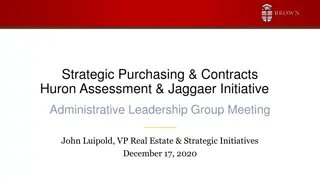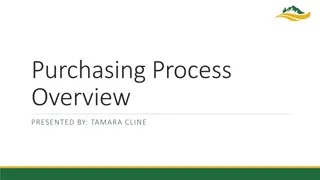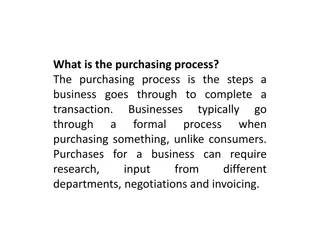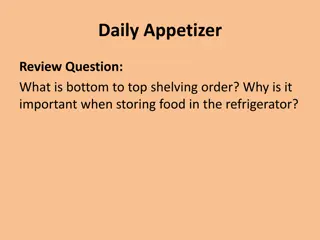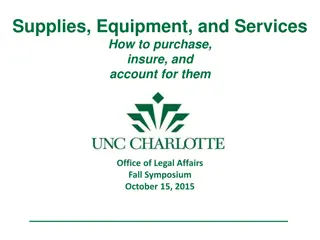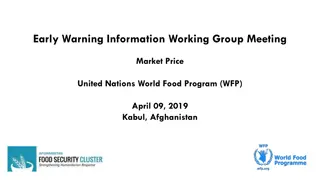Food Service Management II - Purchasing, Receiving & Storing
Understanding the crucial aspects of purchasing, receiving, and storing in food service management is essential for smooth operations. Purchasing involves acquiring the right products at the right time and price, while receiving and storing ensure food quality and safety. Key functions include menu planning, evaluating product quality, and maintaining customer satisfaction. Food buyers play a vital role in upholding ethical standards and identifying quality suppliers. The purchasing process involves various activities such as preparing specifications, receiving deliveries, expediting orders, and managing accounts for payment.
Download Presentation

Please find below an Image/Link to download the presentation.
The content on the website is provided AS IS for your information and personal use only. It may not be sold, licensed, or shared on other websites without obtaining consent from the author. Download presentation by click this link. If you encounter any issues during the download, it is possible that the publisher has removed the file from their server.
E N D
Presentation Transcript
Subject Title : FOOD SERVICE MANAGEMENT-II Subject Code : 16SCCND9
UNIT - II PURCHASING RECEIVING & STORING
PURCHASING Purchasing is the formal process of buying goods and services . Purchasing is the process of getting the right product into facility at the right time and place, plus the amount of goods at the right price and source .
Food Purchase Chart S.No. Types of food Shelf life Examples of food item Meat, fish, poultry, dairy products Potatoes, Onions, Garlic Cereals, Flours, Spices, Canned foods, Nuts Frequency 1. Perishable Short Life Liable to spoil or decay Daily basis 2. Semi perishable Limited shelf life Weekly basis 3. Nonperishable Longer shelf Monthly basis life
Important Functions of Food Purchasing in a Food Service Help in menu planning. Aid to predict profitability of an establishment. Evaluate the quality of the products. Identify the suppliers potential. Maintain customer satisfaction. Know the latest forms of technology, products or services available in the market place.
Food Handling Practices Cost Control Techniques and Price Fluctuations Market and Procedures Knowledge Required for a Food Purchaser Size & Type of Package Food Availability Communication Techniques Storage Facility Suppliers Purchase Quantity & Terms of Supply
Food Buyer Every food buyer needs to possess certain qualities of work effectively such as High moral and ethical values, not influenced by the supplier in any way. Skill in identifying markets Accepting food brands that are marked by standardizing agencies such as ISI, Agmark etc Devotion to duty, being open minded but alert.
PURCHASING ACTIVITY Prepare specification for supplier Receive food & delivery note Demand from Kitchen Prepare order Expedite Order Send requirements on requisition to user department Check order receipts & Invoices Inspect foods Accounts for Payment Stores
FUNCTIONS OF FOOD BUYER To keep records of specifications for each type of dish or menu. Ability to store foods in a manner that will enhance quality of food. Using perishable foods within two days. Applying FIFO / LILO system Buying quality of food.
Methods of Purchasing I. DIRECT DELIVERY Involves direct delivery of food and beverages from the manufacturers to the food service operation. II. FORMAL BUYING Quotations are invited from the sellers, bids are made and the best one is selected. Generally adopted by large catering establishments. III. WHOLESALE BUYING Contract is signed with a wholesaler for purchase of goods at a specific price for a future period. Suitable for large scale food service operation.
Methods of Purchasing IV. BLANKET ORDER PURCHASING An agreement to provide a specified quantity of listed items for a period of time at an agreed price. V. STOCKLESS PURCHASING The buyer does not keep the stocks of goods but the supplier keeps it. Then the buyers get the goods according to the needs. VI. AUCTION BUYING Manufacturers announce the sale of goods. Suitable for large food service operation. VII. ONLINE PURCHASING Ordering food from a local or food cooperative through a web page or app.
GUIDELINES FOR PURCHASING FOODS Check expiry and best before dates and purchase food accordingly. Buy only pasteurized milk and government inspected meat and poultry. Do not buy canned goods in tins that are bulged, dented, rusted or cracked. Do not buy food from unrefrigerated displays that should be in a cooler. Do not purchase eggs that are cracked. Buy seasonal foods. Bulk buying is preferable.
Standard Purchase Specification (SPS) The entire system of purchasing is done on the basis of the menu planned. Once the right market is identified, samples are procured from various suppliers and then tests such as those for quantity and quality are done to narrow these down in a document called Standard purchase specification. SPS helps in creating a standard quality of the product to be required by the organization. Copies of the SPS need to be sent to the following: 1. The purchase department 2. The supplier 3. The Executive chef or the Head chef 4. The receiving department
Standard Purchase Specifications Hotel TAJ Name of product ______________________________ Intended Use _________________________________ Grade Quality ________________________________ Unit ________________ Price per Unit Availability: ___________ month described or all year round Appearance ___________________________________ Texture ______________________________________ Colour _______________________________________ Flavour ______________________________________ Packing ______________________________________ Size and Shape _________________________________ No. per Kg ____________________________________ Any other remarks ______________________________ Signature of purchase Officer Date:
Format of Standard Purchase Specification A purchase specification may be within in a standard form. It may contain: Definition of each item Grade or brand name of the items Weight, sixe or count Unit against which prices should be quoted Special note for the commodity
Preparation of a standard specification has following advantages: Establishing a buying standard of a commodity so that a standard product is available for the customer Inform the supplier in writing by drawing, or photograph or description precisely what is required Provides detailed information to receiving department and store as to the standard of foods to accept Makes staff, chef food and beverage manager, and other staff, aware of the differences that can occur in the size, weight and quantity etc. of the product The specification acts as an aide-memoire to all concerned of what was agreed
RECEIVING Receiving Once the food materials have been ordered for supply their handling at the time of delivery represents the process of receiving. ensure that food is not damaged cross contamination and incorrect weights or volumes.
Delivery Methods Fresh vegetables and fruits may be delivered in jute bags, baskets, cardboard cartons, wooden chests or as such, depending on the texture, nature and perishability of the item. Milk and milk products are generally transported in crates if delivered as pasteurized individual containers. All milk and milk products are delivered in refrigerated vans. Meats may be delivered as whole carcasses or as different cuts as ordered, depending on the quantities involved. Meat if bought minced, is generally delivered in poly bags, or in containers wrapped over with transparent film for easy visibility. Fish should ideally be delivered in ice boxes or in freezer transport vans to be placed straight in freezer storages especially when ordered and supplied in bulk. Poultry is generally supplied as dressed and drawn birds, on weight basis and packed in cartons or large-sized polypacks delivered in refrigerated vans to establishments. Sugar and salt are delivered in polypacks double packed in cartons. Fats and oils in hermetically sealed containers varying from 1 kg to 15 kg. Oils may be supplied even in drums of 50 or 100 kg.
Delivery Procedure The supplier gets an order in writing stating the date on which supplies are required. He passes it on to his stores department or purchasing officers (depending on the perishability of the food). The order is than noted to be kept ready for delivery on the specified date. It is transported to the buyer s stores for receiving. The goods are delivered along with two copies of the delivery challaan or notes one signed by the buyer and returned to the supplier in confirmation of having received the goods; and the second is retained by the buyer for counter checking the bill or invoice when it is received from the supplier for payment. The invoice or bill is then passed on to the accounts department for making the payment.
Receiving Procedure The delivery note is checked with copy of the order placed. Counts, weights or volume are checked to tally with the amounts of various items on the delivery note. The quality of all ingredients are checked with the specifications given to the supplier. Any unacceptable items are returned with the person executing the delivery, along with a note on the delivery challaan stating the items returned. This is countersigned by the receiving authority and the deliverer of the goods. When the delivery note is signed the materials that are delivered have been accepted. In case any damaged item is noticed after the delivery the supplier is informed telephonically. This is followed by a request in writing to replace the same amount with specified quality, in exchange for the received item.
FORMS USED IN RECEIVING PROCEDURE I) PURCHASE ORDER: The receiving clerk should have copy of the purchase order. Compare his purchase order with delivery notes. Usually 3 copies of purchase order are prepared one each for supplier, ordering department & stores Incharge.
FORMS USED IN RECEIVING PROCEDURE ii) Delivery Notes: Accompanied by a delivery which is normally in duplicate. Indicates quantity & quality of items along with their prices. This should tally with purchase order & quotation sheet for quantity & quality. If this found to be correct the 1st copy retained by the receiving clerk & 2nd copy returned to the delivery man.
FORMS USED IN RECEIVING PROCEDURE iii) Invoice: Invoice is the bill which follows the delivery. This will be prepared & given by the seller to the buyer for the net amount to be paid for the items purchased.
Storage of Foods It is the process in which both cooked and raw materials are stored in appropriate conditions for future use without any spoilage . Golden rules for storing food. Clean Cover Cool/Dry
IMPORTANCE OF FOOD STORAGE IN A FOOD SERVICE Preserve wholesomeness of the food. Protect quality of the food ingredients. Maintain expected shelf life of the product. Reduce wastage and spoilage. Control temperature. Prevent food contamination. Ensure safe for consumption. Stabilize the price. Future use. Cope with demand, production on a continuous basis.
Types of Food Storage S.N o. Type of storage Foods to be stored Temp eratu re 21 C Characteristics of storage place 1 Dry storage Cereals, canned foods, flour, sugar, shortenings, spices, certain fruits and vegetables like bananas, onions and potatoes. Should be clean Adequate ventilation with sufficient air circulation Low humidity 2 Refrigerator storage Fresh, cooked or partially cooked foods (milk, meat, vegetables) 0 7 C Regular cleaning of condenser coil should be done Do not open the door frequently Accumulation of ice should be cleared frequently Proper air circulation is preferable. 3 Frozen storage Meat, Ice cream, Butter, Cheese, Milk 18 C
Ideal Ways of Storage S.No . 1 Food ingredients Storage Cereals, pulses Rigid sealed container or metal can 2 Fruits and other vegetables Simple evaporative air cooled cabinets 3 4 5 6 Roots and tubers Milk and milk products Egg Fish Dry place for storage Mechanical refrigerator Egg cartons Wooden or concrete acid resistant tanks 7 Meat Hanging in carefully controlled environments Air tight container Glass or plastic container Cool and dry place Store at appropriate temperature after purchase. 8 9 10 11 Fats and oils Spices Canned foods Frozen foods
Store Records A number of records need to be maintained as foods move very fast in and out of the stores. Requisition Slip: This is a request form submitted by user departments to the stores incharge for the issue of required items. Depending on the size of the establishment and the number of user departments different coloured slips may be used for each department. Department Date Food Item Unit Amount Required Wheat flour Jaggery Kg Kg 5 2 Signature with Date (Requisition Authority)
Material Issue Slip S.No. Items Required quantity Issued quantity Date Remarks
Order Form An order form issued to place orders for supplies with the supplier must be signed by a person authorized to do so. Generally, the catering manager authorizes purchase in a small establishment. Three copies of an order are prepared, one each for supplier, ordering department and stores incharge who receives the goods when they arrive.
ORDER FORM From: Lucky Restaurant To: Food Suppliers Ltd. Please supply the following item by 27/04/2019 Ref: LR/84/3991 Dated: 10/05/2003 Iten Quantity Unit Value Manager (Lucky Restaurent)
GOODS RECEIVED BOOK When all the orders have been executed a Bill Application form quoting all items with invoice numbers is forwarded to accounts for payment. Date Item Description Unit Quantity Order no. Supplier 11.3.2019 A2 Pineapple slices Case 6 24 672314 Gopaljee & Co. Tomato Ketchup bottles 12 620 ml 672314 Gopaljee & Co.
Stock book In this, records of all items received and issued are maintained along with stocks in hand and their monetary value This enables a storekeeper to see at a glance, the quantities of any particular item in stock at any time. It thus helps him to place orders before stocks are completely depleted.
Stock book Item . . . . . . . . . Price . . . . . . . . . . . Unit . . . . . . . . . . Max. Stock Level . . . . . . . . Min. Stock Level . . . . . . . . Date Stock level Received Issued Balance Stock Value of Stock




